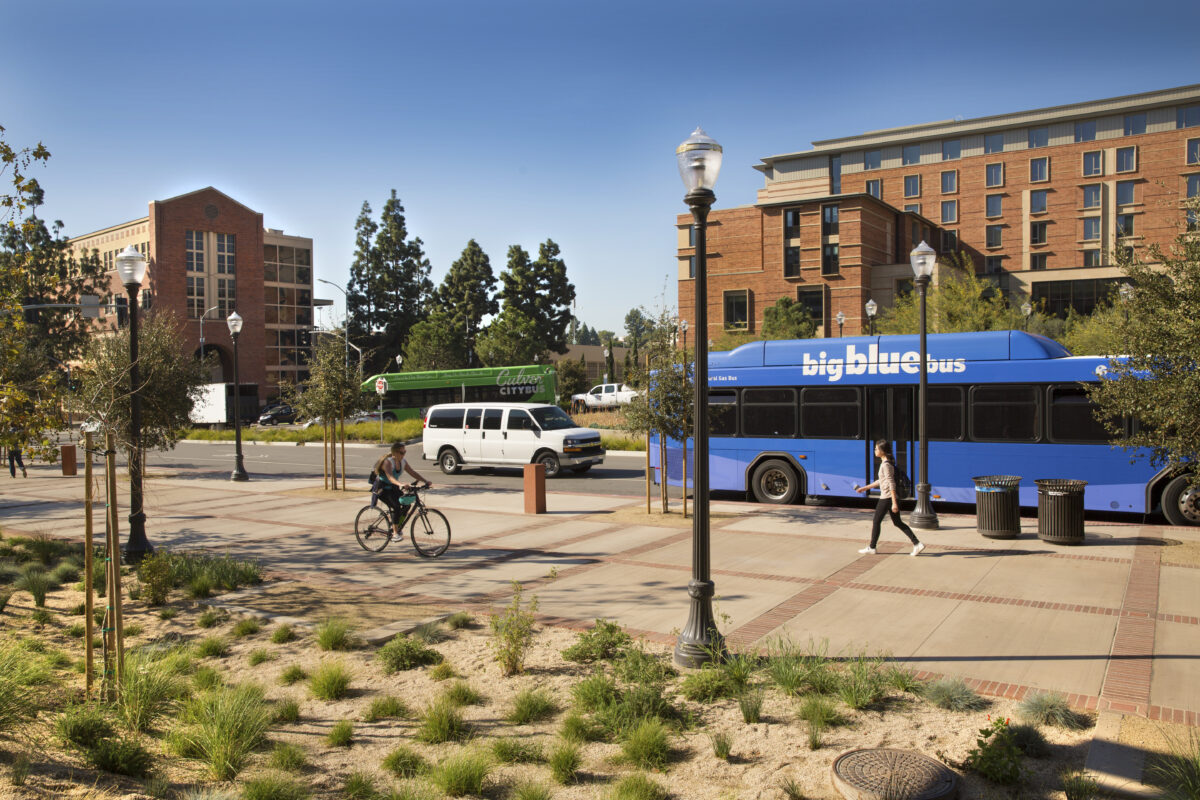

Plan Target: achieve a 45% employee drive-alone commute rate and carbon neutral fleet by 2025
Transportation remains the largest contributor of greenhouse gas emissions in the State of California accounting for 40% in 2017. UCLA’s efforts to reach carbon neutrality from transportation aligns with the campus’ commitment to the American College and University Presidents’ Climate Commitment (ACUPCC) and the UC Policy on Sustainable Practices.
Target goals were set to address commuting, on and near-campus mobility, and campus fleet carbon neutrality to reduce campus mobile source greenhouse gas emissions.
UCLA has a comprehensive award winning sustainable transportation program that offers transit subsidies through seven different transit agencies, a carpool program, walking and bicycling commuter benefits, and more. We also have an Air Travel Mitigation Fund which aims to reduce greenhouse gas emissions from business-related air travel.
After the transition to remote learning and work due to the pandemic, the drive-alone rate significantly decreased in 2020.

Overall in 2020, more than 83% of all commuters travel to UCLA by some form of sustainable transportation. This helps to achieve our long-term goal of at least 70% overall sustainable commuting by 2050.

As the mobility needs for students, faculty, and staff continue to evolve, UCLA will work to improve on- and near-campus mobility so that all active modes and campus transit services are preferable to driving on and around campus. This includes minimizing vehicle trips and leveraging opportunities to plan for first and last mile connections provided by public or private transportation projects.
UCLA is on track to achieve a carbon neutral fleet by 2025, and operates a campus fleet that is more than 60% alternatively fueled and over 30% electric. The switch to low- and zero-emission vehicles saves nearly 5,000 gallons of fuel and an estimated 42.5 metric tons of CO2 each year. UCLA has met their campus fleet goal and increasingly purchases zero emission and sustainable fuel vehicles.
To support these greening initiatives, fuel and power infrastructure is being installed, as well as new technology to identify environmentally unfriendly driving behaviors.
Learn more about how to sustainably commute to campus and reduce your carbon footprint. You can also follow UCLA Transportation on Facebook, Instagram, and X for news and updates, or check out the UCLA Transportation Blog.
Planning Documents
- Key Planning Documents and Awards information
- UCLA Electric Vehicle (EV) Readiness Plan
- UCLA Sustainable Transportation Plan 2019-2026
- UCLA Active Transportation Plan
- UCLA Health Bicycle Corridor Report
- 2015 Sustainable Transportation Plan Progress Report
- UCLA Bicycle Master Plan
- UCLA Climate Action Plan
- Air Travel Mitigation Fund
Annual Reports
- 2024 State of the Commute Report
- 2023 State of the Commute Report
- 2022 State of the Commute Report
- 2021 State of the Commute Report
- 2020 State of the Commute Report
- 2019 State of the Commute Report
- 2018 State of the Commute Report
- 2017 State of the Commute Report
- 2016 State of the Commute Report
- 2015 State of the Commute Report
- 2014 State of the Commute Report
- 2013 State of the Commute Report
- 2012 State of the Commute Report
- 2011 State of the Commute Report
- 2010 State of the Commute Report
Media and Awards
- Managing Campus Mobility on Demand: CHESC Sustainable Transportation Award
- Environmental Responsibility in Fleet Management: Green Fleet Award
- UCLA Newsroom: New electric shuttles serve patients and planet
- UCLA Newsroom: UCLA reaches lowest drive-alone rate yet
- UCLA Magazine Feature: The road to car-free commutes
- Bicycle Friendly University: Gold Level Award
- Best Workplaces for Commuters, Gold Status
